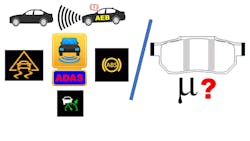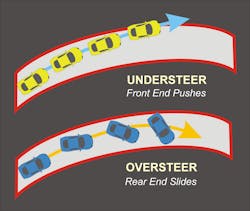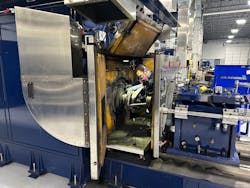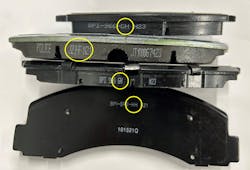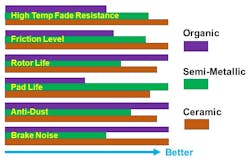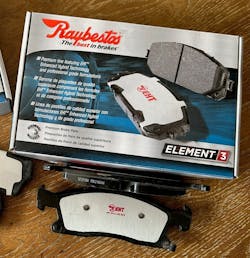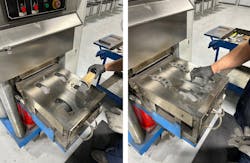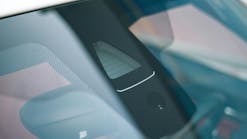Content brought to you by Motor Age. To subscribe, click here.
What You Will Learn:
• Brake linings (pads/shoes) are rated for performance base upon temperature
• The coefficient of friction must betake into consideration when engineering the ADAS brake mitigation software
• Replacing linings with ones of a different frictional coefficient can increase the chances of a collision
Brake pads make a difference
A 2021 model year vehicle is in your shop for brake work. The car has an advanced driver assistance system (ADAS) that includes automatic emergency braking (AEB) and traction control. All four rotors look serviceable, but the brake pads are worn and you replace them with an inexpensive aftermarket pad (OEM pads are too expensive). Will your choice of brake pads cause an unhappy customer leading to a comeback, an accident, or even legal problems for your shop?
The customer picks up his vehicle, drives off and becomes distracted as he approaches a red light at a busy intersection. He fails to apply the brakes in a timely manner, but the ADAS attempts to come to the rescue. The ADAS uses radar/lidar to determine that the vehicle is not slowing sufficiently to avoid hitting a vehicle stopped in the intersection, so it commands the brakes, through the automatic emergency braking system, to apply braking force. The car starts to slow -- but not enough -- and it hits the other vehicle. Why did the AEB system fail?
The replacement low-quality brake pads were made with a compound that had too low of a coefficient of friction (more on this later). Because the brake pad compound did not develop the same friction as quality aftermarket pads or OEM pads, the result was a fender-bender. This scenario could have been much worse—not stopping effectively for pedestrians in a crosswalk. Other issues with ADAS traction control can occur with brake pads that don’t perform as expected.
A vehicle’s braking system uses software that controls ADAS, stability control and emergency braking systems. The software is programmed so that for a given amount of hydraulic brake pressure, the brakes will produce a specific amount of stopping power, or brake torque. The software assumes that the factory-installed brake pads, OEM service replacement, or quality aftermarket pads are installed with a specific coefficient of friction, or friction profile. When OE pads are replaced with pads that use a vastly different friction compound, the ADAS could have problems.
ADAS vs. Brake pad problems
Brake pads that don’t develop sufficient friction could take more time to control the vehicle. If pad material is too aggressive, it could abruptly correct or overcorrect when used for adaptive cruise control, causing uneven brake performance.
Using aftermarket brake pads that have a significant difference in their coefficient of friction from OE pads can cause problems with stability control systems. Often, this can result in overcorrections when the stability control system tries to correct for understeer, which turns the situation into an oversteer condition, with the vehicle possibly ending up unintentionally going off-road.
Understeer, or “pushing,” is when a car turns less than the steering input from the driver, resulting in the car traveling wide of the intended path and occurs when the front wheels lose traction before the rears.
Oversteer occurs when a vehicle turns more than the driver’s input to the steering wheel. This takes place when the rear wheels lose traction before the fronts, resulting in the rear-end sliding out, or a complete spin.
Another issue is the ADAS software’s ability to estimate brake pad temperature. The brake controller monitors how much the brakes are used (based on ADAS, ABS, and stability control system inputs) and calculates if the brakes pads are overheating, which causes brake fade. This condition may cause the controller to temporarily stop the use of stability or traction control until the pads cool down. This scenario is sometimes called brake fade compensation, and because it’s programmed for the friction produced by OE brake pads, any replacement pads should have much the same, or similar, friction characteristics.
Coefficient of friction?
Braking takes place when hydraulic pressure is applied by the driver pressing the brake pedal. The caliper pistons force the brake pads against the spinning rotor to create friction. Friction transforms the kinetic energy of the moving vehicle into heat as the vehicle slows. Braking is simply a matter of converting energy from one form to another. Think of this concept as “horsepower” absorbed by brake systems.
Engines make horsepower by creating heat; braking systems reverse this process by absorbing energy to create heat. Kinetic energy is the weight, or mass, of a vehicle traveling along a road at speed. When the brakes are applied, this energy is converted to heat caused by friction between the brake pads and rotors. And the more heat these components can generate, the more efficiently a vehicle will stop.
If a pickup truck has a weight of 6,400 lbs. and is moving at 60 mph, it has an amount of kinetic energy. When the truck comes to a stop from 60 mph, the kinetic energy is transferred into the braking system as heat. The time elapsed to come to a complete stop from 60 mph is also a factor in how much heat is transferred. If the truck stops in 140 feet, the kinetic energy must be absorbed in around three seconds. Energy transferred in a given time can be expressed as power. In this example, the brakes must absorb 465 hp.
One factor used to rate brake pads is the pad material’s coefficient of friction. This is the ratio of the frictional force between two surfaces (brake pads and rotors) and the force pushing them together (hydraulic pressure on the brake caliper pistons). Friction is the force in which one surface or object (such as a brake pad) rubs against another (such as a rotor) to resist motion. The symbol for coefficient of friction is Mu, or "μ," the 12th letter of the Greek alphabet.
The coefficient of friction that equals 1 takes place when 100kg (kilograms) of force is required to move an object that weighs 100kg. If the same object can be moved with 50kg, the μ is 0.5. The braking torque that takes place during braking, and the hydraulic pressure causing the calipers to push the brake pad material against the rotor’s surface are used to calculate coefficient of friction. The smaller the coefficient of friction, the less force that is required for the brake pads and rotor to slide past each other. The higher the coefficient of friction, the more force that is necessary for the pads and rotors to slide.
There are three factors that relate to the coefficient of friction. Most importantly is for the brake pads to reach their maximum friction level instantly after the brakes are applied. Poor braking power can be attributed to brake pads that do not have a good initial bite against the rotors. The second important factor is the stability of the coefficient of friction at various temperatures. It is common for the coefficient of friction to be lower at low and extremely high temperatures.
The third factor is the stability of the coefficient of friction at different vehicle speeds. Brake pads used for passenger vehicles would be dangerous if a stable coefficient of friction was achieved during braking at 100 mph but the coefficient of friction during braking at 40 mph was unstable. Pads with this μ would work well at a racetrack where vehicle speeds are constantly high but be a disaster on the street because of the lower speeds at which the brakes operate most of the time.
Brake pad friction codes
Some aftermarket brake pads are marked with friction code letters that indicate friction performance. These codes are not U.S. Department of Transportation (DOT) regulated but are used by some, but not all, brake pad manufacturers. Using OE brake pads as a guideline, quality brake pad manufacturers use their own standards for testing to determine friction codes. Friction ratings for brake pads, expressed as μ, or Mu, range from 0.20 to 0.60. On average, OE brake pads have a coefficient of friction of 0.3 to 0.4, and performance brake pads have a coefficient of friction of 0.4 to 0.5. For comparison, full-racing pads can be 0.60 or higher.
A two-letter code is used (SAE Standard J866) to identify the temperatures for pads designed for street use. The first letter designates the normal, low-temperature (200 degrees F to 400 degrees F) friction performance and the second letter the high-temperature (300 degrees F to 650 degrees F) performance. The code letters stand for friction potential with letters in alphabetical order. For example, pads with a “D” rating would not indicate as much friction potential as “E” rated pads. Ideally, street brake pads should have good friction at both high and low temperatures, in which case both letters would be the same, or near the midpoint of the available letter-sequence, like “FF.”
If the first letter is lower than the second letter, it means the pad works better at high temperatures and requires some heat to be fully effective; if the second letter is lower than the first, the pad may fade at high temperatures. Many of the better brake pads intended for street use have a GG friction rating (the highest rating available for street-legal pads). A typical auto parts store carries economy pads that have EE or EF ratings. These pads will work well for most vehicles and drivers. However, if better braking performance is the goal, then pads with minimum FF, GF or FG ratings are a good choice. High-end premium pads are available with ratings like FG or GG. Brake pads used for closed-circuit racing can have HH ratings or higher. The downside of pads with this high friction rating is that they wear out quickly, and many are designed for single-race use.
Identifying codes/letters can be found on the edge of the pads or on the backing plate. Many manufacturers use three groups of alphanumeric characters. The first identifies the manufacturer of the pad material; the second number is the formulation, or composition, of the pad material; and the third group of letters is the coefficient of friction rating and effective temperature range.
Other numbers could be present, including part numbers, manufacturing date codes, and an environmental code that represents the percentage of heavy metals and asbestos fibers used. The environmental code and manufacturing year are usually the very last three digits in the full sequence, but the exact position of the three standard groups of preceding numbers may vary. Some manufacturers use proprietary classifications, such as color-coding the pads or even their own numbering schemes.
Types of brake pads
What matters most with any brake pad replacement is the coefficient of friction between the pad and the rotor. There are three types of brake pad material: organic (non-metallic), semi-metallic and ceramic. Knowing the characteristics of each type will help you select the right material for your customer’s vehicle.
Organic
Organic brake pads provide a low level of friction without producing a lot of heat, making them appropriate for drivers who use their cars for commuting and everyday driving. Organic pads are not a good choice for high-performance cars or heavy-duty applications like SUVs and pickup trucks, as they don’t provide the required stopping power and are prone to brake fade during repeated, heavy braking.
With the high cost of brake rotor replacement, organic pads offer an advantage in that they minimize rotor wear compared to other pad compounds. In use, organic pads provide quiet operation. Another advantage of organic pads is their cost as they are the least expensive of brake pad types. Around 50 percent of new cars sold in the U.S. are factory-equipped with organic brake pads, which are made of a mixture of fibers and other materials, including rubber, carbon compounds, glass or fiberglass, and Kevlar and bound together with resin.
Semi-metallic
These pads come standard for high-performance cars, SUVs and light trucks. Using metal as part of the pad compound makes them ideal for vehicles that continually require high or frequent braking forces to absorb the energy created by heavy vehicles and/or high speeds.
The metal used in these pads makes them more resistant to heat and wear than organic brake pads. However, the metal in the pad compound has a lower coefficient of friction at low temperatures, and more pedal power is required to create the same braking force as organic pads. Semi-metallic pads are made using a blend for synthetics and metals that form a metallic hybrid pad compound. They do have some disadvantages compared to organic pads as they cost more, wear rotors faster and create brake dust and noise.
Ceramic
When ceramic pads for passenger vehicles started showing up in the late ‘90s, they were only found on small Asian cars. As the formulations for ceramic pad materials improved, they were fitted to larger vehicles, including SUVs and light trucks.
Clay and other materials molded into the ceramic pad compound provide a high coefficient of friction, giving them lots of stopping power, the ability to absorb high braking heat, and a high tolerance to brake fade. Don’t confuse ceramic brake pads for passenger cars and light trucks with those intended for use at the racetrack.
When designed for high-performance cars that may be driven on a racetrack, ceramic brake pads excel at absorbing heat once they are up to operating temperature. But that is the inherent problem with using them for normal street driving, as they don’t provide good stopping power when cold.
For example, imagine driving along the Interstate for several hours with no slowing down or stopping. A deer crosses the highway in front of the vehicle and the driver slams on the brakes. Because the racetrack-oriented pads are cold, the vehicle fails to slow down, and the result is an expensive trip to the body shop.
Another disadvantage is that their manufacturing costs are high, as they are the most expensive of brake pad types. Also, because the ceramic pad material doesn’t absorb as much heat as other types of pads, more of the heat from braking will have to be dissipated by the rotors and brake calipers.
What to look for in a pad
Be aware of the friction codes on aftermarket brake pads that you use for replacements. Make sure you have the proper type of pad for the vehicle you are servicing and its intended use. As a rule-of-thumb, brake pads can either provide superior stopping power, last a long time, or have quiet operation — you can’t get all three in one pad.
Use quality aftermarket or OEM pads that come in a box with the company’s name on it. Name brands will have friction rating testing and other information available if there are legal problems related to a possible future accident. Avoid brake pads that come in a “white box” with no markings, as they may not have friction rating test data available, or even identify the manufacturer who made them. The proverb “You get what you pay for” applies, and saving a few dollars using economy, no-name brake pads of a questionable origin may put the “brakes” on your business.
